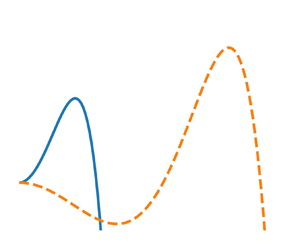Published online by Cambridge University Press: 19 October 2023

In systems where the standard  $\alpha$ effect is inoperative, one often explains the existence of mean magnetic fields by invoking the ‘incoherent
$\alpha$ effect is inoperative, one often explains the existence of mean magnetic fields by invoking the ‘incoherent  $\alpha$ effect’, which appeals to fluctuations of the mean kinetic helicity at a mesoscale. Most previous studies, while considering fluctuations in the mean kinetic helicity, treated the mean turbulent kinetic energy at the mesoscale as a constant, despite the fact that both these quantities involve second-order velocity correlations. The mean turbulent kinetic energy affects the mean magnetic field through both turbulent diffusion and turbulent diamagnetism. In this work, we use a double-averaging procedure to analytically show that fluctuations of the mean turbulent kinetic energy at the mesoscale (giving rise to
$\alpha$ effect’, which appeals to fluctuations of the mean kinetic helicity at a mesoscale. Most previous studies, while considering fluctuations in the mean kinetic helicity, treated the mean turbulent kinetic energy at the mesoscale as a constant, despite the fact that both these quantities involve second-order velocity correlations. The mean turbulent kinetic energy affects the mean magnetic field through both turbulent diffusion and turbulent diamagnetism. In this work, we use a double-averaging procedure to analytically show that fluctuations of the mean turbulent kinetic energy at the mesoscale (giving rise to  $\eta$-fluctuations at the mesoscale, where the scalar
$\eta$-fluctuations at the mesoscale, where the scalar  $\eta$ is the turbulent diffusivity) can lead to the growth of a large-scale magnetic field even when the kinetic helicity is zero pointwise. Constraints on the operation of such a dynamo are expressed in terms of dynamo numbers that depend on the correlation length, correlation time and strength of these fluctuations. In the white-noise limit, we find that these fluctuations reduce the overall turbulent diffusion, while also contributing a drift term which does not affect the growth of the field. We also study the effects of non-zero correlation time and anisotropy. Turbulent diamagnetism, which arises due to inhomogeneities in the turbulent kinetic energy, leads to growing mean-field solutions even when the
$\eta$ is the turbulent diffusivity) can lead to the growth of a large-scale magnetic field even when the kinetic helicity is zero pointwise. Constraints on the operation of such a dynamo are expressed in terms of dynamo numbers that depend on the correlation length, correlation time and strength of these fluctuations. In the white-noise limit, we find that these fluctuations reduce the overall turbulent diffusion, while also contributing a drift term which does not affect the growth of the field. We also study the effects of non-zero correlation time and anisotropy. Turbulent diamagnetism, which arises due to inhomogeneities in the turbulent kinetic energy, leads to growing mean-field solutions even when the  $\eta$-fluctuations are statistically isotropic.
$\eta$-fluctuations are statistically isotropic.